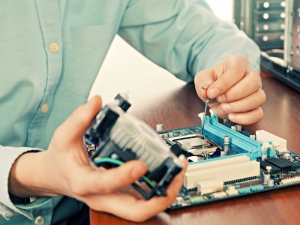Is your hot water system not performing as expected? Hot water systems are quite complex and several things could be causing the problem. Troubleshooting the issue is the first step to getting your system back up and running.
Before you start any sort of repair, ensure you turn off the power supply at the breaker. Working on a hot water system while it's still powered on can be extremely dangerous. If you are dealing with a gas system, make sure you turn off the gas supply as well.
Begin with checking the thermostat settings. If the thermostat is set too low, it might not be able to produce hot water. If it's set too high, it can be a safety risk. The ideal setting is generally between 115 and 125°F. If adjusting the thermostat doesn't help, it's time to seek help from the experts from Dan's Plumbing.
Let's now talk about leaks. Leaks can be caused by a number of issues and are a common problem with hot water systems. Broken drain valves or high pressure in the tank are often the culprits. If you find a leak, immediately contact a professional as this issue can rapidly escalate.
Identify the Problem
Before attempting any repair, determine what's wrong with your hot water system. Perhaps you're dealing with a lack of hot water, inconsistent temperatures or unusual noises.
The issue could be due to a defective thermostat, heating element failure, or a leak in the tank. It's crucial to accurately identify the cause of the problem to choose an appropriate solution.
|
Problem |
Potential Cause |
|
No Hot Water |
Thermostat, Heating Element |
|
Inconsistent Temperatures |
Thermostat |
|
Noises from Tank |
Sediment Buildup |
|
Always seek professional help if you're unsure about diagnosing the issue on your own. |
|
The energy consumption of traditional storage water heaters accounts for approximately 18% of household energy use. Therefore, if your hot water system is malfunctioning or inefficient, it can significantly impact your energy bills. Identifying and addressing issues promptly can aid considerably in energy conservation.
Shutting Off Gas Supply
If your water heater is gas-powered, switching off the gas supply becomes a crucial first step. It's an action you should take swiftly yet carefully to ensure safety.
You can usually locate the supplied gas line at the bottom of the heater. This valve regulates the flow of gas that heats water in your system.
1. Locate the valve: Begin by locating the shutoff valve on the gas line. It should be easy to identify.
2. Turn off the valve: Once located, turn it clockwise (right) to shut it off.
3. Check your work: To confirm it's off, look for a lever running perpendicular to the line indicating that gas supply is blocked.
A correct and safe way of handling this process is essential for your safety and ensuring no further damage is caused to your hot water system.
If you find trouble closing off the gas supply, do not persist in forcing or tampering with it. Instead, contact a professional immediately for assistance to avoid any risks.
Disconnecting the Gas Line
Before starting the hot water system repair, you need to ensure your safety by disconnecting your system from its main power source. If you have a gas water heater, this involves turning off its gas line.
To do this, look for the gas shut-off valve situated on the gas line that connects to your water heater. Its location differs depending on your heater's design and installation setup. Once you locate it, rotate the valve to halt the gas supply flowing into your system.
1. Finding the Gas Valve: It's typically found attached to a flexible tube running to your heater.
2. Shutting Off the Valve: Turn it clockwise until it stops spinning.
Next, begin removing elements connected to your gas line. These include the venting system and draft diverter — precautions required to prevent any potential hazards when servicing any connected parts.
Remember: Tankless water heaters can be up to 34% more energy-efficient than conventional storage tank water heaters for homes that use less than 41 gallons of hot water daily. However, any modifications or repairs should be done carefully and responsibly due to inherent safety considerations related to gas appliances.
Removing and Replacing Parts
To repair a hot water system, you might need to remove and replace some components. Ensure that you follow safety guidelines, like turning off power and draining the water heater first.
Roughly 27 million U.S. households have a water heater that is more than 10 years old. These systems are at higher risk of failure, emphasizing the importance of diligent maintenance.
- Valves: They regulate water flow into and out of the tank. If these fail, they must be replaced swiftly to prevent leakage or overflow.
- Thermostat: This component controls the water temperature. An incorrect reading may result in excessively hot or cold water.
- Heating elements: Usually, there are two, if one fails, the water might not heat adequately.
Once you've identified the faulty component, purchase a replacement part from a reputable supplier. Disconnect the faulty part carefully to avoid causing further damage to your system.
You should then install the new part as per the manufacturer's instructions. Make sure everything is securely fastened and correctly aligned before powering back up your system.
Reconnecting and Testing System
After addressing the main issues with your hot water system, it's essential to reconnect and test all its features. Start by ensuring that all parts are correctly replaced and properly functioning.
Reassemble Components
Begin by reassembling any components you may have dismantled. This includes valves controls, heating elements, or tank parts. Make sure each piece is securely in its place to prevent leaks or malfunctions.
Restore Power Supply
Once you've successfully reassembled the components, restore the power supply to your hot water system. Check all electric connections if an electric heater or make sure gas supply is functioning well for gas heaters.
Refill With Water
With power restored, now you can proceed to refill your hot water system with water. Open your water supply line and fill up your tank until it is completely full. Be cautious during this process to prevent overflow or unnecessary spillage.
Test for Efficiency
Last but not least, it's testing time! Check if your hot water system is efficiently heating up the water as expected. Also, confirm if any leaks persist. Remember: fixing a simple leak could save homeowners around 10% on their water bills.
Preventative Maintenance Steps
Preventing problems with your hot water system starts by knowing its lifespan. The average lifespan of a water heater is 8-12 years, so aim for regular check-ups to ensure smooth operation within this period.
Drain Sediment Regularly
Over time, sediment buildup can affect the efficiency of your water heater. To prevent this, drain a few gallons from the tank every three months. This will also help detect any potential leaks early.
Pressure Relief Valve Check
The pressure relief valve is a crucial part of your hot water system as it prevents build-up of excessive pressure. Checking and replacing it yearly ensures your system's safety and longevity.
Inspect the Anode Rod
The anode rod attracts corrosive elements, keeping your tank intact. Make it a point to inspect the rod about every three years to prevent any long-term damage to your setup.
Maintain Adequate Insulation
Held without insulation, losses in heat can increase your energy bills disturbingly. Ensure consistently efficient operation by insulating both your pipes and heaters.
Monitor Water Temperature
Setting your water temperature too high may not only waste energy but also risk overheating or causing burns. Aim for about 120 degrees Fahrenheit for optimal safety and efficiency.
Use Qualified Professionals
If you're unsure about tackling these steps by yourself, don't hesitate to employ certified professionals specializing in hot water systems. Their expertise can often prevent costly mishaps or prolonged inconveniences.
Common Water Heater Problems
Your water heater can develop various problems, disrupting the warm comfort of your showers or washing-up routines. Diagnosing these complications early can prevent extensive damage to your system.
Poor water heating could be due to a faulty thermostat. It's responsible for controlling the system's temperature. A malfunctioning one could result in cold showers instead of pleasant, warm ones.
- Frequent overheats: If your water is scalding hot, likely your thermostat setting is too high.
- Inconsistent temperatures: Your system's heating elements might have issues if you're experiencing alternating hot and cold water.
- Noisy tanks: Sediment build-up at the bottom of your tank usually causes banging or rumbling noises during heater operation.
The cost to repair a water heater varies widely depending on the type of repair, ranging from $150 to over $800, with an average of around $. Some issues, like thermostat failure or element breakdowns, may be cheaper to fix than replacing an entirely corroded tank.
You should engage professional help if you're inexperienced with water heaters critical components. They are specially trained to diagnose and repair various types of water heating systems flawlessly.






